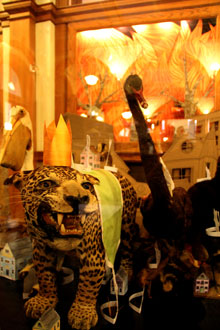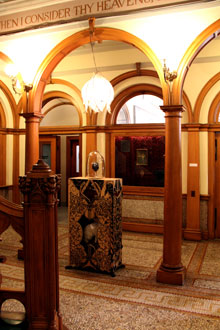.jpg)
BIRD’S-EYE VIEW An image by Carlson and Carpenter. |
A fact underlying the exhibit "Curiouser," in the lobby of the Providence Museum of Natural History (Roger Williams Park, 1000 Elmwood Avenue, Providence, through September 2012), is that less than two percent of the institution's collection of 250,000 preserved birds, insects, mammals, rocks, fossils, and Native American baskets is on view at any time.

PARADE The Potters’ Royal Re-homing Procession. |
Curators (and couple) Erik Carlson and Erica Carpenter see this as untapped potential. As in the first version of the project here in 2010, they invite artists to dig into these treasures, "freeing them from the strict imperatives of science and analysis" to "present specimens from the museum's 19th-century collections in a transformative light, seeking out secret narratives, latent myths and hidden agendas."Pippi Zornoza's Rabbit Cabinet is an oak cabinet set on little wooden animal feet and screenprinted with ornate patterns of roses, candles, and a vulture. A large cracked black egg sits in a bell jar on top. Windows into the cabinet reveal a taxidermied white rabbit nervously peeking out, a bat skeleton, and dead birds set on ceramic jewelry holders in the shape of gloved hands. Zornoza makes the weirdness of the taxidermied critters even weirder with her surreal juxtapositions — dead birds on the delicate, disembodied hands. The results are beautiful, thorny, uncanny.
Judith Klausner mulls how the museum can turn vermin into precious specimens by marching ants (fashioned from beads) across a sparkly beaded purse and decorating an elegant cup and saucer with cockroach designs. Victor Signore sets a bat, hummingbirds, and a seahorse in cubbies amongst a wall of bricks and backlit glowing orange glycerin blocks, musing on how humanity builds walls and taxonomy systems to separate ourselves from nature, though we are animals too. Klausner and Signore's installations have an alluring creepiness, but the ideas don't resonate strongly.
Nick and Erin Potter remember their move across the country to Providence with a taxidermied leopard, heron, pelican, skunks, rabbit, and bear parading through little paper houses and flat, cutout, antic cartoon monsters and people. Behind them stand flat paper houses, trees, and flames.

UNCANNY BEAUTY Zornoza’s Rabbit Cabinet. |
Gina Siepel's Habitat Reclassified is a padlocked filing cabinet with the five drawers labeled with various bird names. The back of the metal cabinet has been removed and replaced with a Plexiglas window, revealing taxidermied birds, some matching the labels on the drawer fronts, perched on an abstracted wood tree, with its squared limbs penetrating through the drawers. The presentation is stiffly done, but suggests that the birds killed and gathering dust in filing cabinets have come back to life. Siepel's drawers imagine an ark cradling a living ecosystem, instead of a crypt. It can lead to thoughts of how the Victorians' voracious collecting and exploitation of natural resources have lead us to the threatened world we inhabit today.Throughout the show, the taxidermied critters are innately compelling — beautiful and dead and restored to an awkward approximation of life. But the art itself often becomes more decorative than intriguing. The museum setting and taxidermy seem to limit the artists' imaginations to goth and the Victorian legacy of museum archiving. Goth is cool, but it often becomes a predictable Tim Burton recipe of bones, lace, and lovely gloom.